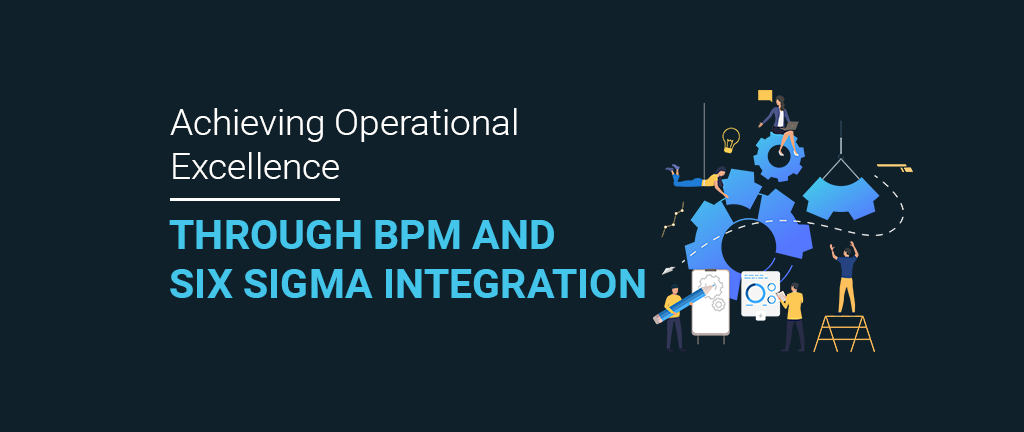What do organisations need to do to stay agile, relevant and competitive? How can they future-proof their business and ensure an upward trajectory for their year-on-year growth rate?
While an organisation’s continued growth doesn’t depend on a single factor, one key element that lies at the centre of it is its commitment towards operational excellence. Its dedication to continually look at inefficiencies in its processes and procedures and improving them for increased efficiency, productivity and effectiveness. Two methodologies that have proven to be highly effective in achieving operational excellence are Business Process Management (BPM) and Six Sigma.
While both disciplines aim to improve productivity and quality, both have different routes to reaching the goal. In this blog, we will look at how each discipline works and how the synergies of the two can improve the results.
Understanding Business Process Management and Six Sigma
Business Process Management (BPM) involves the identification, mapping, implementation, monitoring, and optimisation of business processes. It provides a systematic framework for managing and improving processes to align them with organisational goals. BPM links improvement and process design efforts directly to the management system and the organisational strategy. This allows organisations to achieve efficiency and increase profitability by focusing on their customer and business needs through effective process performance.
On the other hand, Six Sigma is a data-driven methodology focused on reducing process variation, eliminating defects, and improving quality by using statistical analysis and rigorous problem-solving techniques. The focus of the methodology is to help organisations figure out what is preventing them from making their business processes more predictable and stable. This helps to minimise tolerances in output and achieve pre-defined objectives.
Thus, Six Sigma focuses on specific process improvement techniques, while BPM provides a broader framework for managing and optimising end-to-end processes.
While Six Sigma is valuable for eliminating waste and variability, it may not fully address the complexities and interdependencies of a larger process ecosystem. In contrast, BPM takes into account the end-to-end process flow, including stakeholder involvement, resource allocation, and technology enablement, to optimise overall performance and achieve strategic objectives.
BPM and Six Sigma: A Powerful Combination for Operational Excellence
BPM and Six Sigma are complementary disciplines, each offering unique strengths that, when integrated, create a powerful combination for operational excellence. Integrating the data-driven focus of Six Sigma with the real-time controls and automation of BPM helps organisations drive substantial benefits, including:
Customer Focus and Quality Improvement: The synergy of BPM’s customer-centric approach and Six Sigma’s focus on reducing process variations and defects enable organisations to consistently deliver high-quality products and services that meet customer requirements, resulting in increased customer satisfaction and loyalty.
Data-Driven Process Improvement: Six Sigma brings measurement, statistical analysis, and disciplined problem-solving to the table, enabling data-driven decision-making. As a framework, BPM facilitates measuring and monitoring process performance using metrics and measures determined by Six Sigma. This integration provides real-time visibility into process performance and facilitates the proactive identification of areas for improvement.
Improving Long-Term Performance: By integrating BPM and Six Sigma, organisations can achieve sustained performance improvements by streamlining processes, eliminating waste, and continuously monitoring and analysing performance metrics. This synergy allows organisations to drive efficiency, enhance quality, and maintain a culture of continuous improvement, leading to improved long-term performance and competitiveness in the market.
Getting the Best of the Both Worlds: Integrating BPM with Six Sigma
Integrating Six Sigma and BPM can bring significant benefits to organisations, driving process optimisation and overall performance. To successfully integrate the two disciplines, organisations need to follow the below steps:
Apply Six Sigma to improve inefficient processes: Utilise Six Sigma principles and tools to identify and address process inefficiencies, reducing variations and enhancing overall process performance. This step lays the foundation for subsequent BPM integration.
Manage processes with BPM: Once processes have been improved through Six Sigma, leverage BPM to automate and manage these optimised processes. BPM provides the necessary infrastructure and technology to streamline operations, enhance efficiency, and ensure consistent execution.
Utilise Six Sigma for measurements and analysis: Deploy Six Sigma methodologies for measuring process performance, conducting statistical analysis, and applying a disciplined approach to problem-solving. This ensures data-driven decision-making.
Measure and monitor process performance with BPM: Utilise BPM as a framework to measure and monitor process performance using metrics and measures determined by Six Sigma. This integration enables real-time visibility into process performance, proactive identification of areas for improvement and timely decision-making.
Align improvement efforts with organisational strategy: Apply BPM as the methodology to directly link process improvement and design efforts with the organisational strategy. This ensures that improvement initiatives are aligned with the overall goals and objectives of the organisation, driving sustainable results.
Harnessing the Combined Potential
Collectively, BPM and Six Sigma disciplines provide the basis for the sustainable growth of an enterprise and help it become agile in an ever-changing business environment.
One tool that is designed to help organisations to tap into the huge opportunities offered by combining the two disciplines is PRIME BPM. A powerful cloud-based, plug-and-play software, PRIME BPM, combines the strengths of BPM, Lean, Six Sigma and Value Stream Mapping methodologies. The software packs together the capability of BPM to provide a holistic approach to managing and optimising end-to-end processes, as well as Six Sigma’s focus on reducing process variations and defects to drive greater impact.
Wish to explore the powerful features and functionalities of the PRIME BPM tool at Zero Cost? Get access to a Free License.
